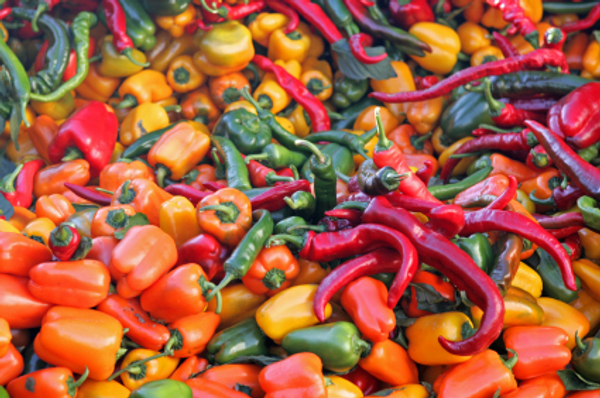---------- Forwarded message ----------
From: George Mateljan <gmf@mauigateway.com>
Date: Tue, Sep 4, 2012 at 12:05 AM
Subject: WHFoods Weekly Newsletter
George Mateljan Foundation, PO Box 25801, Seattle, Washington 98165
From: George Mateljan <gmf@mauigateway.com>
Date: Tue, Sep 4, 2012 at 12:05 AM
Subject: WHFoods Weekly Newsletter
 |  The George Mateljan Foundation, a not-for-profit foundation with no commercial interests or advertising, is a new force for change to help make a healthier you and a healthier world. |
Farmers' markets are now 7,864 strong, and their numbers are up 9.6% from last year and double the number from 2004! California tops the list (with 827 markets) along with New York, Massachusetts, Michigan, and Wisconsin. The latest tally was announced in preparation of National Farmers Market Week, which took place from August 5-12 and was described by the Secretary of Agriculture as a week-long commemoration "to further awareness ... of the many contributions farmers make to daily life in America." Farmers' markets are a great place to purchase seasonally and locally — something we strongly promote at WHFoods. The vendor is often the same person who raised the bees for fresh unpasteurized honey, grew vegetables that are bursting with freshness, raised the goats for amazing varieties of cheese, or scattered the feed for the chickens that laid multicolor eggs unlike you've ever seen in your local market. While vegetables may not all be certified organic, you are likely to find many that have been grown without the use of pesticides or herbicides. You will also find an absence of genetically modified crops or foods packed with high-fructose corn syrup. It's a place where samples abound, and stories behind the products are easy to come by. With the obesity epidemic looming largely over our country, the rise in the number of farmer's markets is not only encouraging, but it may be the place where we will bear witness to national changes to a healthier way of eating. And with the $4 million USDA grant issued in May with the aim to make them food stamp friendly, the products found at farmers' markets will become available to a much wider range of customers. While many farmers' markets are now open year-round, this is the best time of year to find the largest number of tables and bins filled with fresh fruits and vegetables. I encourage you to take advantage of the bounty provided at your local farmers' market. Watermelon Watermelon has an extremely high water content, approximately 92%, giving its flesh a juicy and thirst-quenching texture while still also subtly crunchy. As a member of the Cucurbitaceaefamily, the watermelon is related to the cantaloupe, squash, pumpkin, cucumber, and gourds that grow on vines on the ground. Watermelon is rich in the carotenoid phytonutrient, lycopene, which isespecially important for our cardiovascular health, and an increasing number of scientists now believe that it is important for bone health as well. What You Should Know About Watermelon Alongside of tomatoes, watermelon has moved up to the front of the line in recent research studies on high-lycopene foods ... The Latest News About Watermelon. Best Food Sources for: Enjoy your Healthiest Way of Eating this week! George |
weekly newsletter
Check Out What's New On Our Website
Kids are back to school! With statistics showing half of all students dropping out before graduation, it is high time we acknowledge the correlation between academic success and high-level performance with a healthy diet ... How a Healthier Way of Eating Affects Success in School
Food of the Week . . . Watermelon
Did you know that the phenolic compounds in watermelon — including flavonoids, carotenoids, and triterpenoids — make this fruit a choice for anti-inflammatory and antioxidant health benefits? If you had to pick a single nutrient from this anti-inflammatory and antioxidant category that has put watermelon on the map, that nutrient would be lycopene. Alongside of pink grapefruit and guava, watermelon is an unusually concentrated source of this carotenoid. Whereas most fruits get their reddish color from anthocyanin flavonoids, watermelon gets it reddish-pink shades primarily from lycopene. The lycopene content of watermelons increases along with ripening, so to get the best lycopene benefits from watermelon, make sure that your melon is optimally ripe. Read More If you have any questions about today's Newsletter Ask George Your Question 5-Minute Watermelon Frappe  view recipe ... The Food Tip of the Week: How to Select the Best Watermelon Here is the Daily Tip for this week: Fats have been given a bad reputation. What are fats and why do we need them? Fats are probably the most interesting macromolecules in food because there are so many different types of fats. Unfortunately, food fats have been given a bad reputation, in part because body fat is the way we store excess calories ... I love your book that I purchased a few years ago. Your passion for healthy living is an inspration for me that I found myself sharing with others. Thank you for leading the way. - Damien |
George Mateljan Foundation, PO Box 25801, Seattle, Washington 98165
| To unsubscribe or change subscriber options visit: http://www.aweber.com/z/r/?LKzMrGyMtKyM7MwcLAwctEa0jKysbCxsjKw= |
"Be the best, do your best, expect the best"




 How to Order
How to Order




